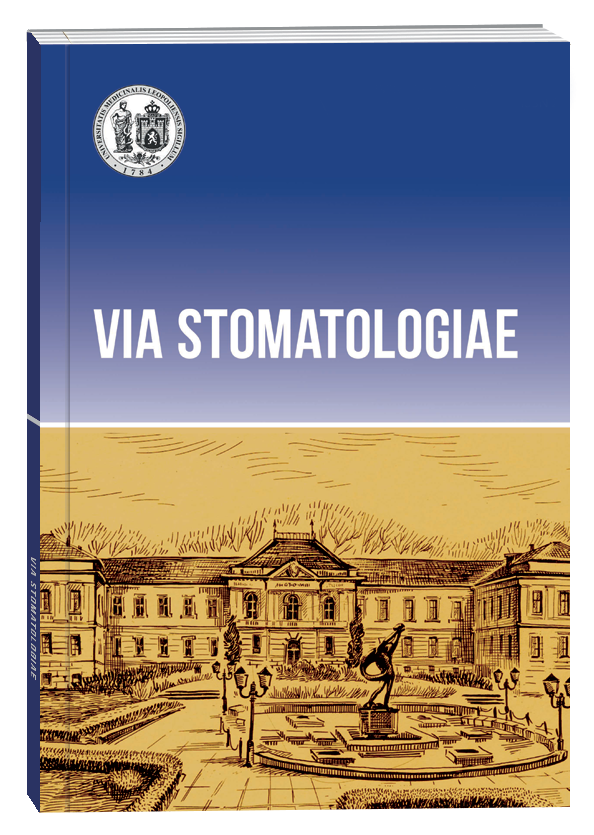DENTAL HEALTH OF CHILDREN IN EDUCATIONAL AND REHABILITATION CENTERS
DOI:
https://doi.org/10.32782/3041-1394.2024-3.2Keywords:
children, dental health level, dental caries, chronic catarrhal gingivitis, malocclusionsAbstract
Introduction. Children’s dental health is an urgent problem today, which is associated with a high prevalence of stomatological diseases morbidity. According to the data of professional literature, the growth of diseases is facilitated by the combined effect of a complex of factors: somatic pathology, environmental, social, psychoemotional stress, which play a leading role in the etiology and pathogenesis of dental diseases, contribute to a decrease in the protective properties of the child’s body. The use of various preventive measures helps to reduce the incidence, but the problem remains. Therefore, it is important to investigate the dental status of children in various educational institutions, identify risk factors, the occurrence of diseases and to develop measures to eliminate them. The aim of the study. On the base of indicators of dental morbidity, to assess the level of dental health of children who are in educational and rehabilitation centers. Research materials and methods. To assess the dental health level, 215 children aged 7–18 years who are in the educational and rehabilitation centers of communal institutions of the Lviv Regional Council (main group) and 185 children of the same age in secondary schools (comparison group) were examined. The condition of the hard tissues of the teeth, periodontium, the level of oral hygiene and the presence of malocclusions were determined in children. Based on the results of the disease prevalence data, the level of dental care and dental health of children were assessed. Results. It has been determined that the prevalence of dental caries in children of the main group is, on average, 91,35 ± 3,83% with an intensity of 6,38 ± 0,5 tooth, which are significantly higher than in children of the comparison group (72,66 ± 3,81% and 3,79 ± 0,48 tooth) and corresponds to a high level of intensity according to WHO criteria. The number of unfilled carious teeth is 4,88 ± 0,67 tooth in children of the main group, which significantly exceeds the value of filled teeth – 1,28 ± 0,27 tooth. In children of the comparison group, this ratio is 1,69 ± 0,39 tooth and 1,94 ± 0,17 tooth, respectively. The level of dental care according to the DMF index is assessed as insufficient (17,66%), which corresponds 86,15% of the need for dental caries treatment in children. A very low level of dental care was found in the age group of children aged 7–9 years (12,87%) and 10–12 years (12,78%). The dental health level of children is, on average, 56,25% in the main group of children and 68,75% in the comparison group. With age, the dental health level of children in the main group decreases and at the age of 16–18 years is 45%. Conclusions. It has been established that the prevalence of caries, periodontal diseases and malocclusions in children in educational and rehabilitation centers is significantly higher than in the comparison group. A significant predominance of carious unfilled teeth relative to filled teeth was determined, which indicates insufficient oral cavity sanitation. The insufficient level of dental care and low level of dental health of children was revealed, mainly due to the presence of multiple caries, untreated and complicated forms of caries, which indicates the lack of preventive measures and insufficiency of the system of organization of dental care for children in educational and rehabilitation centers.
References
Руда І.В., Попова О.І. Епідеміологія карієсу зубів у дітей віком 5–7 років м. Вінниці. Вісник проблем біології і медицини. 2014. № 2 (2). С. 126–129.
Оцінка стоматологічного статусу дітей 6–7 років, які постійно проживають в умовах біогеохімічного дефіциту фтору та йоду / О.В. Клітинська та ін. Україна. Здоров’я нації. 2019. № 3. С. 43–50.
Епідеміологічні дослідження та моніторинг стоматологічної захворюваності в дітей України / А.О. Янчук та ін. Світ медицини та біології. 2019. № 2. С. 154–158.
Котельбан А.В., Ратушняк А.І. Пародонтологічний статус у дітей Буковини. Вісник стоматології. 2022. № 3 (45). С. 104–108.
Костура В.Л., Безвушко Е.В. Поширеність та структура захворювань тканин пародонта в дітей із надмірною масою тіла. Клінічна стоматологія. 2017. № 2. С 42–48.
Клінічна епідеміологія прогнатичного (дистального) прикусу / С.І. Дорошенко та ін. Новини стоматології. 2017. № 2. С. 74–76.
Смоляр Н.І., Лесіцький М.Ю. Поширеність аномалій зубних рядів у дітей 6–16 років. Клінічна стоматологія. 2021. № 2. С. 63–70.
Аналіз індексної оцінки потреби в ортодонтичному лікуванні підлітків Закарпатської області / О.В. Клітинська та ін. Проблеми клінічної педіатрії. 2021. № 1. С. 6–14.
Prevalence and change of malocclusions from primary to early permanent dentition: a longitudinal study / L. Dimberg et al. Angle Orthod. 2015. № 5 (85). P. 728–734.
Khalid G., Metzner F., Pawils S. Prevalence of dental neglect and associated risk factors in children and adolescents : A systematic review. Int. J. Paediatr. Dent. 2022. № 3 (32). P. 436–446.
Чинники ризику розвитку захворювань твердих тканин зубів у дітей. Сучасний стан питання / О.І. Годованець та ін. Медицина сьогодні і завтра. 2019. № 4. С. 111–120.
Малко Н.В. Інтенсивність хронічного катарального гінгівіту у дітей, які проживають на екологічно забрудненій території. Актуальні проблеми сучасної медицини : вісник Української медичної стоматологічної академії. 2016. № 4 (1). С. 20–22.
Білинський О.Я., Костенко Є.Я. Генетичні та епігенетичні фактори виникнення карієсу. Сучасна стоматологія. 2021. № 1. С. 18–22.
Risk factors and gingival inflammation in children aged 10 to 14 years – an epidemiological study Journal of IMAB. Н / N. Tankova et al. 2021. № 27 (4). P. 4092–4097. https://doi.org/10.5272/jimab.2021274.4092.
Стан місцевого імунітету порожнини рота у дітей із запальними захворюваннями пародонта на тлі туберкульозу / Е.В. Чухрай та ін. Вісник стоматології. 2023. № 125 (4). С. 108–114. https://doi.org/10.35220/2078-8916-2023-50-4.19.
Показники карієсу постійних зубів з урахуванням ступеня його активності в підлітків, які навчаються в різних закладах освіти / Л.Ф. Каськова та ін. Український стоматологічний альманах. 2021. № 1. С. 83–87.
Данилюк Д.В., Чухрай Н.Л. Стан тканин пародонта у дітей, які перебувають у навчально-реабілітаційних центрах. Український стоматологічний альманах. 2024. № 1. С. 83–87.
Лещак О.М., Попель С.Л. Реакція буккального епітелію на стандартне фізичне навантаження в дітей 8–10 років, які перебувають у дитячому оздоровчому закладі. Вісник Прикарпатського національного університету. Серія «Фізична культура». 2012. № 15. С. 44–52.
Особливості стоматологічної захворюваності у дітей із дитячим церебральним паралічем / А.І. Максименко та ін. Вісник стоматології. 2023. № 121 (4). С. 86–91. https://doi.org/10.35220/2078-8916-2022-46-4.15.
Jan B.M., Jan М.М. Dental health of children with cerebral palsy. Neurosciences (Riyadh, Saudi Arabia). 2016. № 21 (4). P. 314–318. https://doi.org/10.17712/nsj.2016.4.20150729.
Prevalence of gingivitis in children with autism spectrum disorders (ASD) / I. Yakubova et al. Wiadomosci Lekarskie (Warsaw, Poland: 1960). 2023. № 76 (1). P. 84–89.
Безвушко Е.В., Гутор Т.Г. Стоматологічний рівень здоров’я дітей, які проживають у різній за екологічною ситуацією місцевості. Новини стоматології. 2008. № 3. С. 56.







